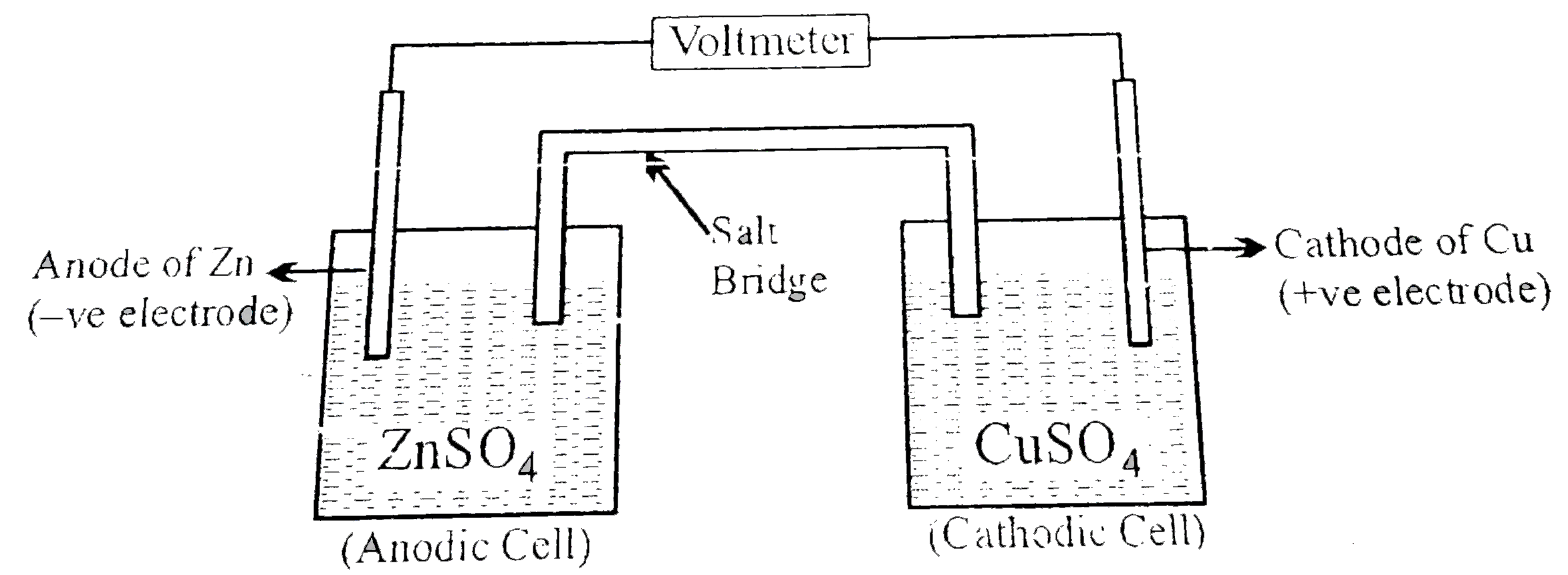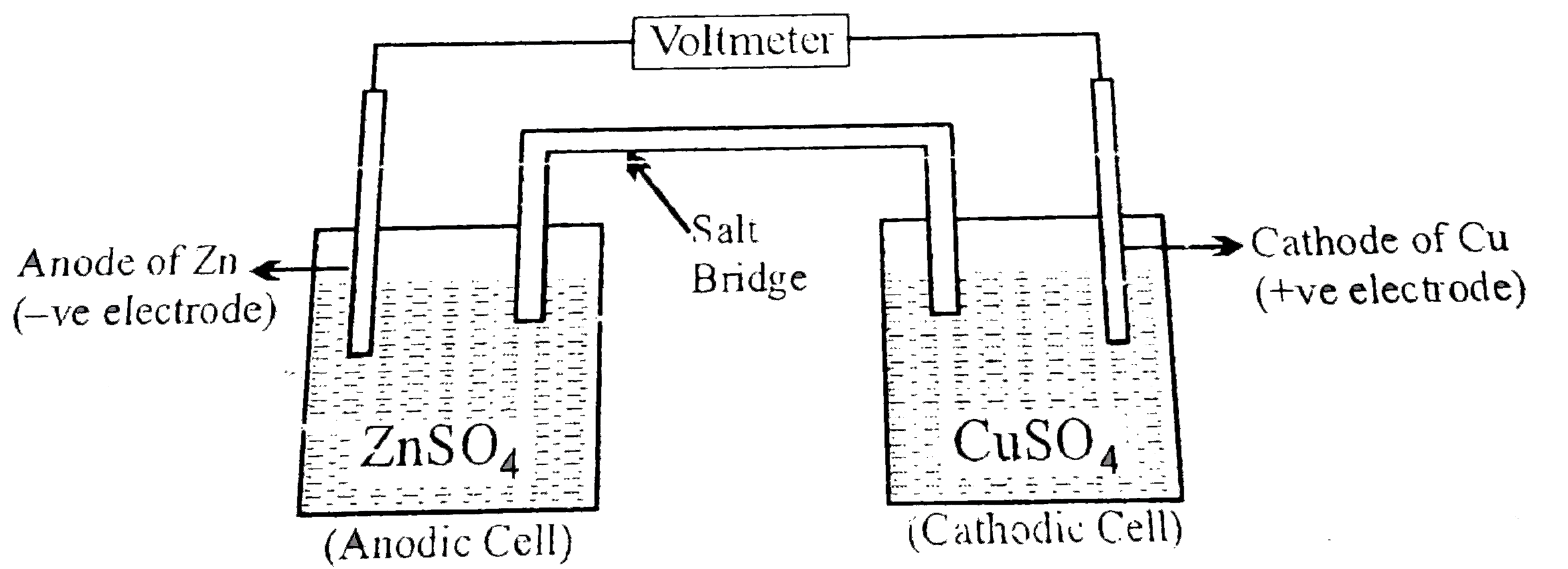In a Daniel cell,
the chemical energy liberted during the redox reaction is converted to electrical energy
the electrical energy of the cell is converted to chemical energy
the energy of the cell is utilised in conduction of the redox reaction
the potential energy of the cell is converted into electrical energy.
The correct Answer is:A
To solve the question regarding the Daniel cell, we will analyze the components and reactions occurring in the cell step by step.
Step 1: Understanding the Daniel Cell
A Daniel cell is a type of galvanic cell that converts chemical energy into electrical energy through redox reactions. It consists of two half-cells: one containing zinc and the other containing copper.
Hint: Remember that a galvanic cell generates electricity from spontaneous chemical reactions.
Step 2: Identifying the Anode and Cathode
In a Daniel cell:
- The anode is where oxidation occurs. In this case, zinc (Zn) is oxidized to zinc ions (Zn²⁺).
- The cathode is where reduction occurs. Copper ions (Cu²⁺) are reduced to solid copper (Cu).
Hint: Oxidation involves the loss of electrons, while reduction involves the gain of electrons.
Step 3: Writing the Half-Reactions
At the anode:
Zn→Zn2++2e−
At the cathode:
Cu2++2e−→Cu
Hint: Each half-reaction shows the process occurring at the respective electrodes.
Step 4: Overall Cell Reaction
Combining the half-reactions, we get the overall reaction for the Daniel cell:
Zn+Cu2+→Zn2++Cu
Hint: The overall reaction represents the transfer of electrons from the anode to the cathode.
Step 5: Energy Conversion
In a Daniel cell, the chemical energy released during the redox reaction is converted into electrical energy. This is the fundamental principle behind the operation of galvanic cells.
Hint: Focus on the relationship between chemical reactions and energy conversion.
Conclusion
Thus, the correct statement regarding the Daniel cell is that it is a galvanic cell where zinc acts as the anode and copper as the cathode, and the chemical energy liberated during the redox reaction is converted into electrical energy.
Final Answer:
- The correct option is that the chemical energy liberated during the redox reaction is converted into electrical energy.
A Daniel cell is a type of galvanic cell that converts chemical energy into electrical energy through redox reactions. It consists of two half-cells: one containing zinc and the other containing copper.
In a Daniel cell:
- The anode is where oxidation occurs. In this case, zinc (Zn) is oxidized to zinc ions (Zn²⁺).
- The cathode is where reduction occurs. Copper ions (Cu²⁺) are reduced to solid copper (Cu).
At the anode:
Zn→Zn2++2e−
At the cathode:
Cu2++2e−→Cu
Combining the half-reactions, we get the overall reaction for the Daniel cell:
Zn+Cu2+→Zn2++Cu
In a Daniel cell, the chemical energy released during the redox reaction is converted into electrical energy. This is the fundamental principle behind the operation of galvanic cells.
Thus, the correct statement regarding the Daniel cell is that it is a galvanic cell where zinc acts as the anode and copper as the cathode, and the chemical energy liberated during the redox reaction is converted into electrical energy.
- The correct option is that the chemical energy liberated during the redox reaction is converted into electrical energy.
Topper's Solved these Questions
- BOOK - NCERT FINGERTPS ENGLISHCHAPTER - ELECTROCHEMISTRYEXERCISE - HOTS10videos
ELECTROCHEMISTRY
- BOOK - NCERT FINGERTPS ENGLISHCHAPTER - ELECTROCHEMISTRYEXERCISE - EXEMPLAR PROBLEMS17videos
ELECTROCHEMISTRY
- BOOK - NCERT FINGERTPS ENGLISHCHAPTER - COORDINATION COMPOUNDS EXERCISE - Assertion And Reason15videos
COORDINATION COMPOUNDS
- BOOK - NCERT FINGERTPS ENGLISHCHAPTER - GENERAL PRINCIPLES AND PROCESSES OF ISOLATION OF ELEMENTSEXERCISE - Assertion And Reason15videos
GENERAL PRINCIPLES AND PROCESSES OF ISOLATION OF ELEMENTS
Similar Questions
In a Daniell cell, electrons flow from zinc electrode to copper electrode outside the cell.
View SolutionAssertion (A): In a Daniell cell, if the concentration of Cu2+ and Zn2+ ions are doubled, the EMF of the cell will be doubled.
Reason (R): If the concentration of ions in contact with metals is doubled, the electrode potential is doubled.
(a)If both (A) and (R) are correct, and (R) is the correct explanation of (A).
(b)If both (A) and (R) are correct, but (R) is not the correct explanation of (A).
(c)If (A) is correct, but (R) is incorrect.
(d)If (A) is incorrect, (R) is correct.View SolutionFill in the blanks by choosing the appropriate word/words from those given in the brackets:
(ionic conduction, electronic conduction, anode, cathode, one coulomb, one faraday of their equivalent weights, of their molecular weights, decoration, Avogadro's number, proton number, loss of electrons, gain of electrons, can, cannot, e.m.f., negative, positive, greater, H2, sodium, less, more, bad, good, increases, decreases electrode potential, negative, positive, greater, less, H2,O2, more).
In a Daniell cell, the copper vessel serves as.........View SolutionWhen a Daniel cell is connected in the secondary circuit of a potentiometer, the balancing length is found to be 540 cm. If the balancing length becomes 500 cm. When the cell is short-circuited with 1Ω, the internal resistance of the cell is
View SolutionWhat is the representation of a Daniell cell ?
View SolutionAssertion : For the Daniel cell, Zn/Zn2+∣∣∣Cu2+∣∣Cu with Ecell=1.1V results into flow of electron from cathode to anode.
Reason : Zn is deposited at anode and Cu is dissolved at cathode.View SolutionStatement-I: In the Daniel cell, if concentration of Cu2+ and Zn2+ ions are doubled the emf of the cell will not change.
Because Statement-II: If the concentration of ions in contact with the metals is doubled, the electrode potential is doubled.View SolutionCalculate the EMF of a Daniel cell when the concentartion of ZnSO4 and CuSO4 are 0.001M and 0.1M respectively. The standard potential of the cell is 1.1V.
View Solution
The most pupular electrochemical cell, daniel cell was originally developed by the English chemist john F daniel the general assembly of the cell is as given below An undergraduate student made a Daniel cell using 100cm3 of 0.100MCuSO4 ad 0.100M ZnSO4 solution respectively. The two compartments are connected by suitable salt bridge.
[given E∘(Cu2+/Cu)=0.34V,E(Zn2+/Zn)=−0.76V,2.30RTF=0.06,log2=0.3]
Q. Calculate the emf (in volt) of the above cell.View Solution
The most pupular electrochemical cell, daniel cell was originally developed by the English chemist john F daniel the general assembly of the cell is as given below An undergraduate student made a Daniel cell using 100cm3 of 0.100MCuSO4 ad 0.100M ZnSO4 solution respectively. The two compartments are connected by suitable salt bridge.
[given E∘(Cu2+/Cu)=0.34V,E(Zn2+/Zn)=−0.76V,2.30RTF=0.06,log2=0.3]
Q. A labmate of the student asked her for some solid CuCl2. while she was lifting the bottle from a shelf, the lid of the bottle slipped and some amount of CuCl2 fell in the CuSO4 compartment at constant volume. She measured the emf of the cell again and found that it has increase by 9 mV. She used this data to calculate the amount of CuCl2 that had spilled in the compartment. Calculate the mass of CuCl2 that had spilled into the daniel cell? (molar mass of CuCl2=135gmol)View Solution

